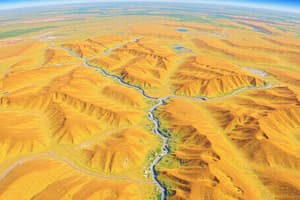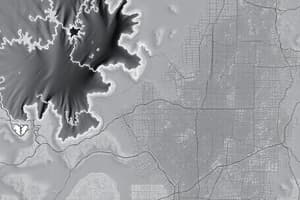Podcast
Questions and Answers
Which of the following best describes the primary advantage of using remote sensing in ecological studies?
Which of the following best describes the primary advantage of using remote sensing in ecological studies?
- It provides a broad spatial perspective, enabling monitoring of large or inaccessible areas. (correct)
- It guarantees higher data accuracy compared to traditional field surveys.
- It allows for detailed microscopic analysis of soil samples.
- It eliminates the need for any ground-based data collection, reducing field work.
What is the key difference between a Digital Elevation Model (DEM) and a Digital Surface Model (DSM) derived from LiDAR data?
What is the key difference between a Digital Elevation Model (DEM) and a Digital Surface Model (DSM) derived from LiDAR data?
- A DEM includes vegetation and buildings, while a DSM only shows the terrain.
- A DEM is created using hyperspectral data, while a DSM is created using LiDAR data.
- A DEM represents the top of all objects, while a DSM represents the bare Earth surface.
- A DEM represents the bare Earth surface, while a DSM represents the top of all objects. (correct)
How does LiDAR technology enable ecologists to study forest structure?
How does LiDAR technology enable ecologists to study forest structure?
- By directly measuring the age of trees through laser penetration of the bark.
- By using sound waves to create acoustic maps of the forest understory.
- By emitting laser pulses and measuring the time it takes for the light to return, creating detailed 3D maps of the forest. (correct)
- By capturing high-resolution imagery of individual leaves, which permits species identification .
A researcher aims to assess the health of a forest by detecting early signs of plant stress and nutrient deficiencies. Which remote sensing technology would be most suitable for this?
A researcher aims to assess the health of a forest by detecting early signs of plant stress and nutrient deficiencies. Which remote sensing technology would be most suitable for this?
Which of the following is NOT a typical application of hyperspectral imagery in ecological research?
Which of the following is NOT a typical application of hyperspectral imagery in ecological research?
How does the Airborne Observation Platform (AOP) of the National Ecological Observatory Network (NEON) contribute to ecological research?
How does the Airborne Observation Platform (AOP) of the National Ecological Observatory Network (NEON) contribute to ecological research?
A research team is studying the impact of deforestation on local biodiversity. They need to quickly assess changes in habitat structure and composition over a large, previously inaccessible area. Which combination of remote sensing technologies would be most effective?
A research team is studying the impact of deforestation on local biodiversity. They need to quickly assess changes in habitat structure and composition over a large, previously inaccessible area. Which combination of remote sensing technologies would be most effective?
A scientist wants to monitor the effects of a prolonged drought on plant health in a grassland ecosystem. Which capability of hyperspectral imagery makes it particularly useful for this task?
A scientist wants to monitor the effects of a prolonged drought on plant health in a grassland ecosystem. Which capability of hyperspectral imagery makes it particularly useful for this task?
Which of the following is a primary advantage of combining LiDAR and hyperspectral data in ecological studies?
Which of the following is a primary advantage of combining LiDAR and hyperspectral data in ecological studies?
How does remote sensing contribute to understanding the effects of climate change on ecosystems?
How does remote sensing contribute to understanding the effects of climate change on ecosystems?
Which of the following steps is essential during hyperspectral data processing?
Which of the following steps is essential during hyperspectral data processing?
Why is ground truthing important in remote sensing projects?
Why is ground truthing important in remote sensing projects?
What is a key challenge associated with using remote sensing data in ecological research?
What is a key challenge associated with using remote sensing data in ecological research?
How can remote sensing data be used in monitoring forest carbon stocks effectively?
How can remote sensing data be used in monitoring forest carbon stocks effectively?
What role does Google Earth Engine play in ecological remote sensing?
What role does Google Earth Engine play in ecological remote sensing?
In the context of remote sensing, what does temporal resolution refer to?
In the context of remote sensing, what does temporal resolution refer to?
What advancement in remote sensing technology allows for flexible and high-resolution data collection?
What advancement in remote sensing technology allows for flexible and high-resolution data collection?
Which aspect of an ecosystem can be directly informed by hyperspectral data?
Which aspect of an ecosystem can be directly informed by hyperspectral data?
Flashcards
Remote Sensing
Remote Sensing
Gathering information about an object without direct physical contact.
Common Remote Sensing Platforms
Common Remote Sensing Platforms
Satellites, airplanes, and drones.
Remote Sensing Sensors
Remote Sensing Sensors
Cameras, LiDAR, and spectrometers.
LiDAR
LiDAR
Signup and view all the flashcards
LiDAR: Time-of-Flight
LiDAR: Time-of-Flight
Signup and view all the flashcards
Digital Elevation Model (DEM)
Digital Elevation Model (DEM)
Signup and view all the flashcards
Hyperspectral Imagery
Hyperspectral Imagery
Signup and view all the flashcards
Spectral Fingerprinting
Spectral Fingerprinting
Signup and view all the flashcards
NEON AOP Data
NEON AOP Data
Signup and view all the flashcards
LiDAR in Ecology
LiDAR in Ecology
Signup and view all the flashcards
Hyperspectral Data
Hyperspectral Data
Signup and view all the flashcards
LiDAR & Hyperspectral Synergy
LiDAR & Hyperspectral Synergy
Signup and view all the flashcards
Vegetation Phenology
Vegetation Phenology
Signup and view all the flashcards
LiDAR Data Products
LiDAR Data Products
Signup and view all the flashcards
Hyperspectral Data Processing
Hyperspectral Data Processing
Signup and view all the flashcards
Ground Truthing
Ground Truthing
Signup and view all the flashcards
Drones in Remote Sensing
Drones in Remote Sensing
Signup and view all the flashcards
Google Earth Engine
Google Earth Engine
Signup and view all the flashcards
Study Notes
There is no new information to add or changes to make to the existing notes.
Studying That Suits You
Use AI to generate personalized quizzes and flashcards to suit your learning preferences.




